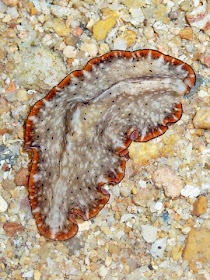
After having a quick look at the resident giant clam, I went on my search for the Feather stars (Order Comatulida)! Here's one bright red one found underwater.

There were not only one but many of these stunning Red feather stars. Am so relieved they are still doing well on the island. :)

Here's the Black feather stars when they have white arms and black pinnules. Most feather stars only come out to feed at night. During the day, they hide in crevices or among coral, curling up their arms in tight coils.

This is how the feather stars look like when they are not curled up! They look very pretty, don't you agree?

Same too for those that are bright red in colour.

I also chanced upon this larger feather star with pinnules of varying shades of black and white. It was original found perching on a coral.

As for this feather star with a tinge of blue and orange in additon to its black and white coloration, there is something special on this star that James noticed.

James found a commensal on top of an arm of the feather star. It seems to be well camouflaged, with colours and patterns matching the host. We have no idea what it is! It is quite a pity we didn't check its underside to confirm its identification. But it was moving. We have not seen this before.

Yet at another black coloured feather star, James also noticed a worm-like commensal on the oral disk or the calyx of the feather star. These creatures are too small for us to handle though. Though their identity remains a mystery, I'm excited because it is my first time seeing a commensal on a feather star.

The reefs at Little Sisters Island did not disappoint and it is crowded with life: hard corals and sponges.

And here we have the zoanthids and the hard coral living side by side. I wonder is it a peaceful one or one that is on war for space.

One of the special hard corals found on the shore is this Circular mushroom coral. This mushroom coral has a pretty single slit-like mouth with purle and white banded 'lips'.

This hard coral looks really stunning in detail and it is the Encrusting horn coral (Hydnophora sp.). The unique features of this Hydnophora coral are the small conical mounds and their short blunt tentacles that are green in colour here.

When night falls, we got the rare opportunity to photograph the Cave corals (Tubastrea sp.) with their tentacles extended out. The polyps of the cave corals lack symbiotic algae (zooxanthallae) and usually only expand at night to feed on plankton.

This is another cave coral that is white in colour. It was found on the underside of a rock.

And what a joy to find so many of the black-version of the Cave corals! Though they have yet to extend their tentacles, there is some hint of their tentacles with tints of green from what we can see.

At some parts of the reef, there are also many of the Flowery soft corals (Family Nephtheidae). It was quite a pity we didn't take some time to look closely for the allied cowries.

An interesting sponge seen during the trip is this spiky one that I do not know what it is. I don't think it is in the Sponge guide book as I tried flipping and could not find it listed.

The Orange-edged black flatworm (Pseudobiceros uniarborensis) was found. This flatworm has a white outer edge and an orange inner edge.

Whereas, this flatworm that looks rather similar has a yellow outer edge and a white inner edge. I think it may possibly be another species of the Pseudobiceros genus.

James sharp eyes found this special flatworm that was also recently first sighted on another southern shore. It is something new and its identity still unknown. Some help to their identity will be greatly appreciated.

I think the Bohol nudibranch (Discodoris boholiensis) is in season as I saw three on this particular trip itself.

But the best nudibranch find must be the two Blue dragon nudibranch (Pteraeolidia ianthina) that Ria found! It is ever so pretty in its neon-purple coloration!

The blue dragon nudibranch has the ability to capture zooxanthellae and store them within its body. Here, the zooxanthellae get protection and in turn provides the nudibranch with much of the nutrients produced through photosynthesis. In addition, this nudibranch also eats hydroids.

Talking about hydroids, I found this Decorator crab (Camposcia retusa) that did not have sponge on its upper surface but hydroids!

On some rocky crevices, some movements were noticed and I went to observe what the animal was and I found that there was a Snapping shrimp (Family Alpheidae).

Towards the end of the rather long trip, Geraldine shared with me her find of the Spider conch (Lambis lambis). It has yet to reach its full adult size and is medium sized.

Well that's not all, the team also found two of the rare and special Clear sundial snail (Architectonica perspectiva)! It's only my second time seeing this intricate looking snail, my first was at St John's Island.

And the final climax of the evening's spectacular trip was this Spotted-tail frogfish (Lophiocharon trisignatus) that James saw. At first he thought he saw some weird looking fish, since it is quite well camouflaged until Chay Hoon went over and take a look to confirm its identity.
Indeed it was a wonderful trip topped with pleasant weather! Makes me love Little Sister's Island more. Hope to come back again soon.
More finds and photos of the day's trip in my Flickr gallery: http://www.flickr.com/photos/koksheng/archives/date-taken/2010/01/03/
those feather stars and sea slugs are very cute in looking
ReplyDelete